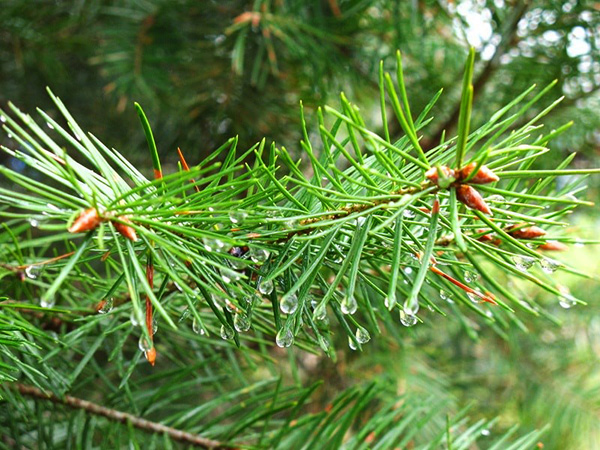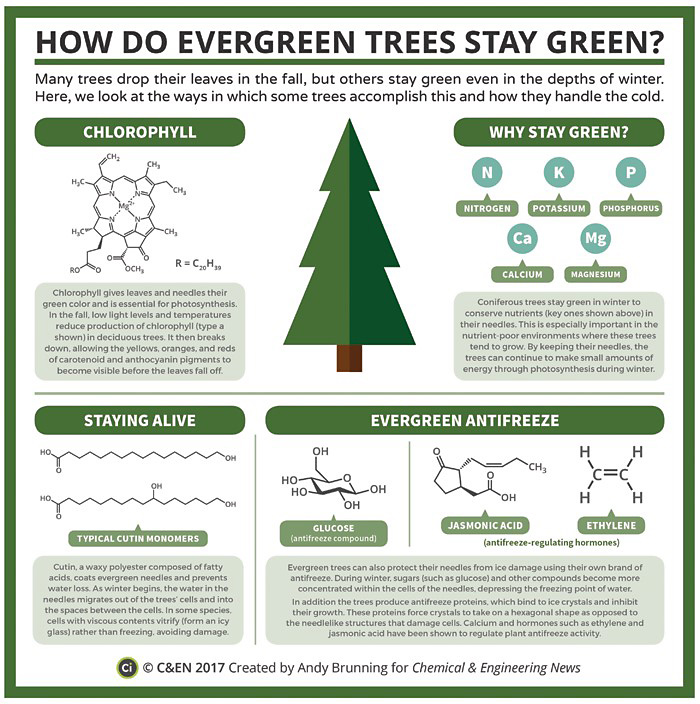
To make it through winter, trees have developed two very different strategies.
Deciduous trees, whose broad leaves are too delicate to survive the freeze, pull their sugars back into the body of the tree and let their leaves die and fall, as we explored in a previous EarthDate.
Coniferous trees—like pine, spruce, fir, and cedar—have a few different solutions.
First, their “leaves” are needles, adapted to the cold. They’re thick, have less surface area, and are coated with a waxy substance called cutin, which traps moisture within them.
So that the needles are not damaged by freezing, as cold weather approaches, water within their cells moves to spaces between the cells and concentrates with sugar to lower its freezing point.
The whole tree, in fact, produces a protein that acts like antifreeze, binding ice crystals and causing them to form less-damaging hexagonal shapes instead of their traditional needle form.
This system works so well that evergreen needles can stay on trees through several winters. They fall off only due to age and are quickly replaced by new needles.
By retaining their leaves, evergreen trees also retain their nutrients. Preserving their nitrogen, potassium, phosphorus, calcium, and magnesium allows them to survive in extreme environments, like high-mountain soils that may have little of these minerals.
And staying green throughout the late fall and early spring allows them to conduct photosynthesis and produce sugars when deciduous trees can’t.
Background

Synopsis: When we think of winter scenery, we often picture a snowy vista including beautiful evergreen trees. Why do some trees lose their leaves for the winter while others maintain green leaves?
- The two primary categories of trees, deciduous and evergreen, evolved different strategies to succeed through the low light and freezing temperatures of winter.
- Deciduous, or hardwood, trees have tender, broad leaves filled with water-soluble sugary sap. In temperate regions, these trees must protect themselves from freezing.
- Twigs, stems, and buds can survive winter. Leaves, however, are too tender to survive freezing, so deciduous trees slow photosynthesis and harvest the sugars stored in their leaves. (You may have enjoyed such harvested sugars for breakfast as maple syrup!)
- Once the green chlorophyll fades, the remaining pigments create fall colors: oaks tend to turn red, brown, or russet; maples range from bright scarlet to yellow; hickories turn golden bronze; and aspen glow in shades of gold and yellow.
- Trees dispose of their spent leaves, dropping them to the ground, where their remaining nutrients may be recycled into the soil.
- When winter turns to spring, deciduous trees must regrow their leaves before they can start photosynthesis and grow again.
- Evergreens are green year-round—they never lose all their leaves at one time.
- Most evergreens—such as pine, fir, spruce, juniper, and cedar—are cone-bearing conifer trees with needles that stay on the tree for several years, only falling off because of old age, to be quickly replenished.
- Some broad-leafed shrubs like holly may also keep their leaves year-round.
- The chlorophyll that keeps conifer needles “evergreen” requires energy to create and maintain. Rather than shutting down chlorophyll production, evergreens expend the needed energy to sustain it because of the benefits.
- With chlorophyll in their leaves year-round, most conifers are able to produce energy via photosynthesis through the autumn and even into the depths of winter. In the spring, these trees can start photosynthesis immediately, without having to grow new leaves.
- Research has shown that, at high elevations, photosynthesis does shut down in some evergreen trees in winter, yet they still keep their needles.
- A second big advantage to holding on to their leaves is retaining nutrients like nitrogen, potassium, phosphorus, calcium, and magnesium, making it possible for evergreens to grow in nutrient-poor soil that might be too harsh for hardwoods.
- The needle-shaped leaves of conifers have tough external coatings of cutin, a waxlike substance that helps to protect and trap fluids inside the leaves. The fluids themselves act like antifreeze to keep the life-giving parts of the needles from freezing.
- In the winter, water moves out of the needle cells into spaces between the cells, preventing ice damage. The fluids become more concentrated in sugars, depressing their freezing temperature.
- Conifers also produce antifreeze proteins that bind to ice crystals, inhibiting their growth and forcing them to take a hexagonal shape instead of their normal needle-like form.
- Calcium and hormones regulate the “evergreen antifreeze” activity.
- Like their cold-weather cousins, dry-climate conifers like cypress and cedar evolved flat waxy scales to prevent water loss during drought conditions.

